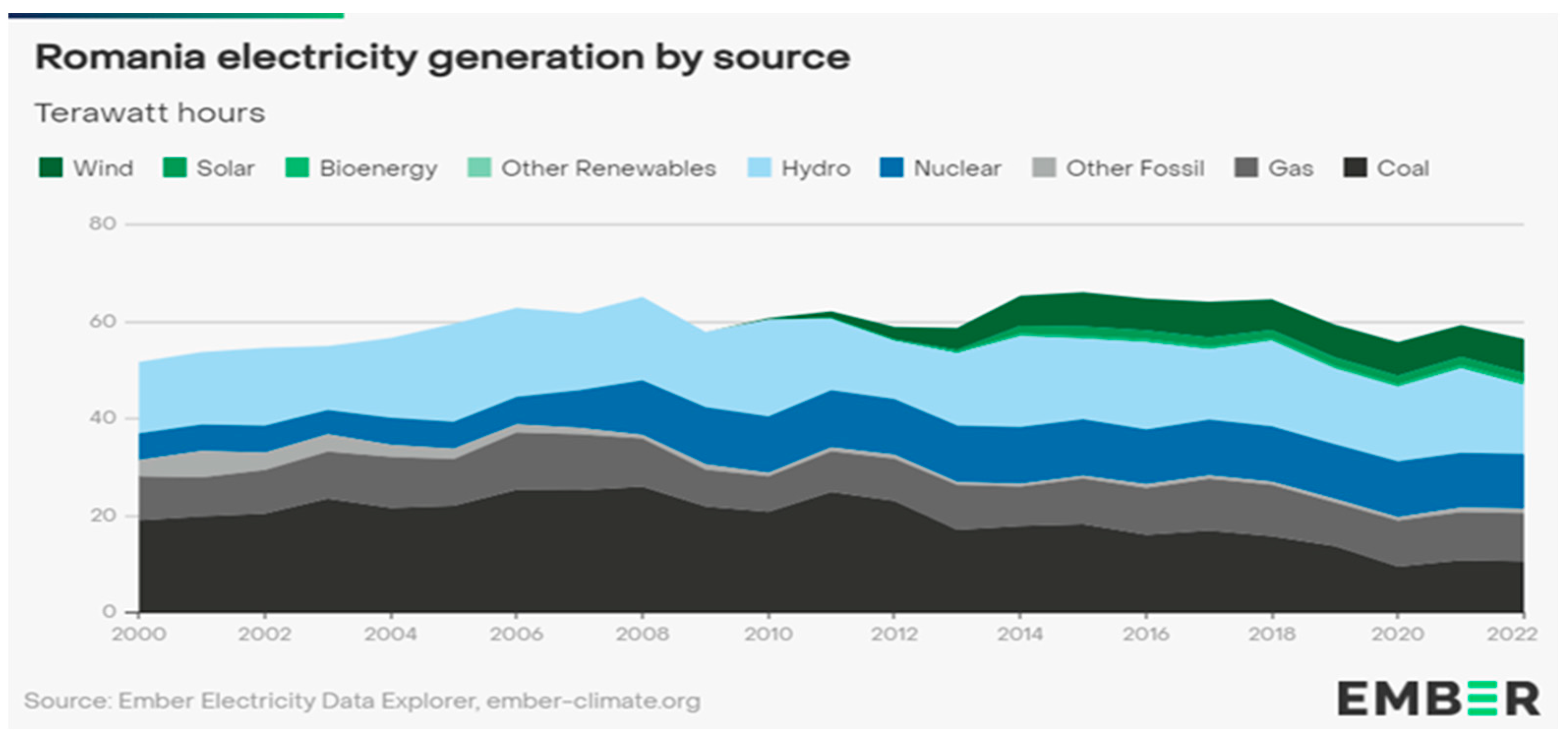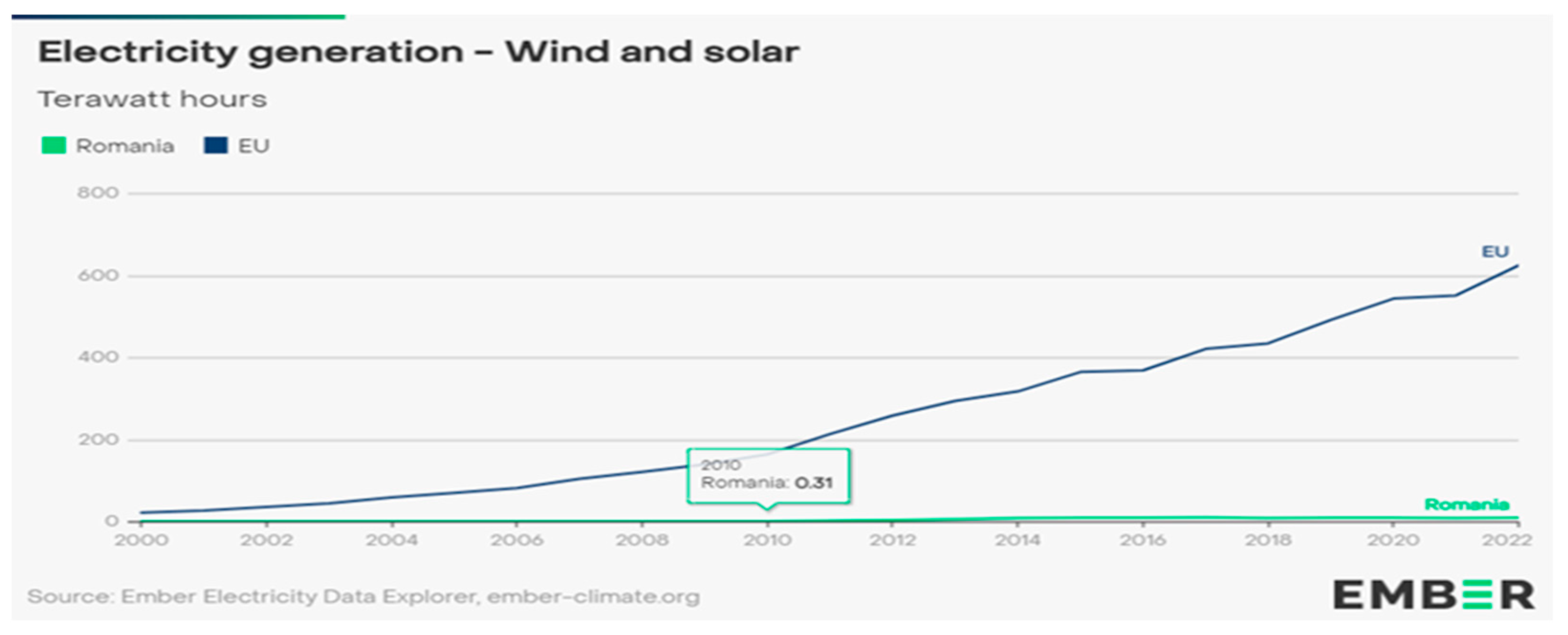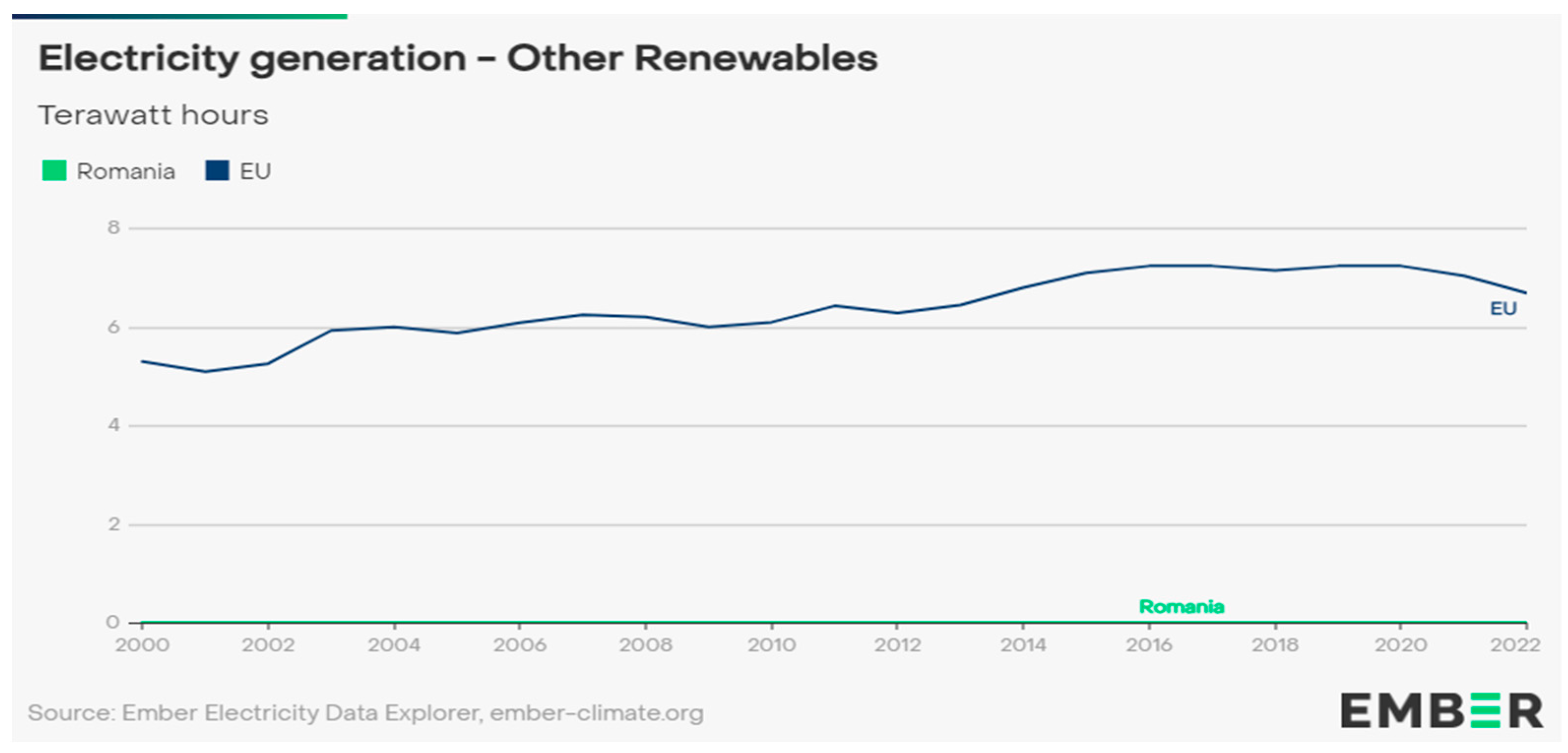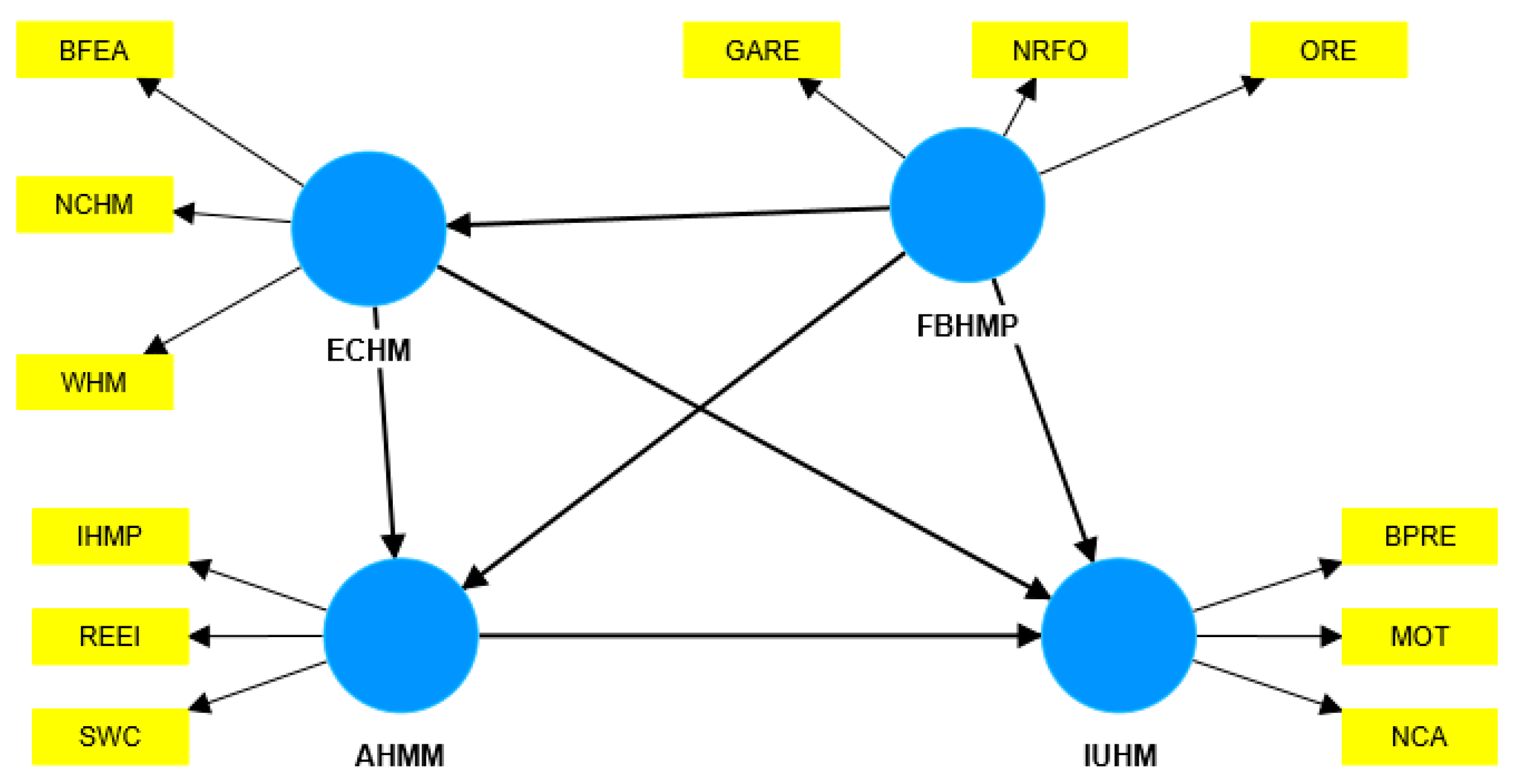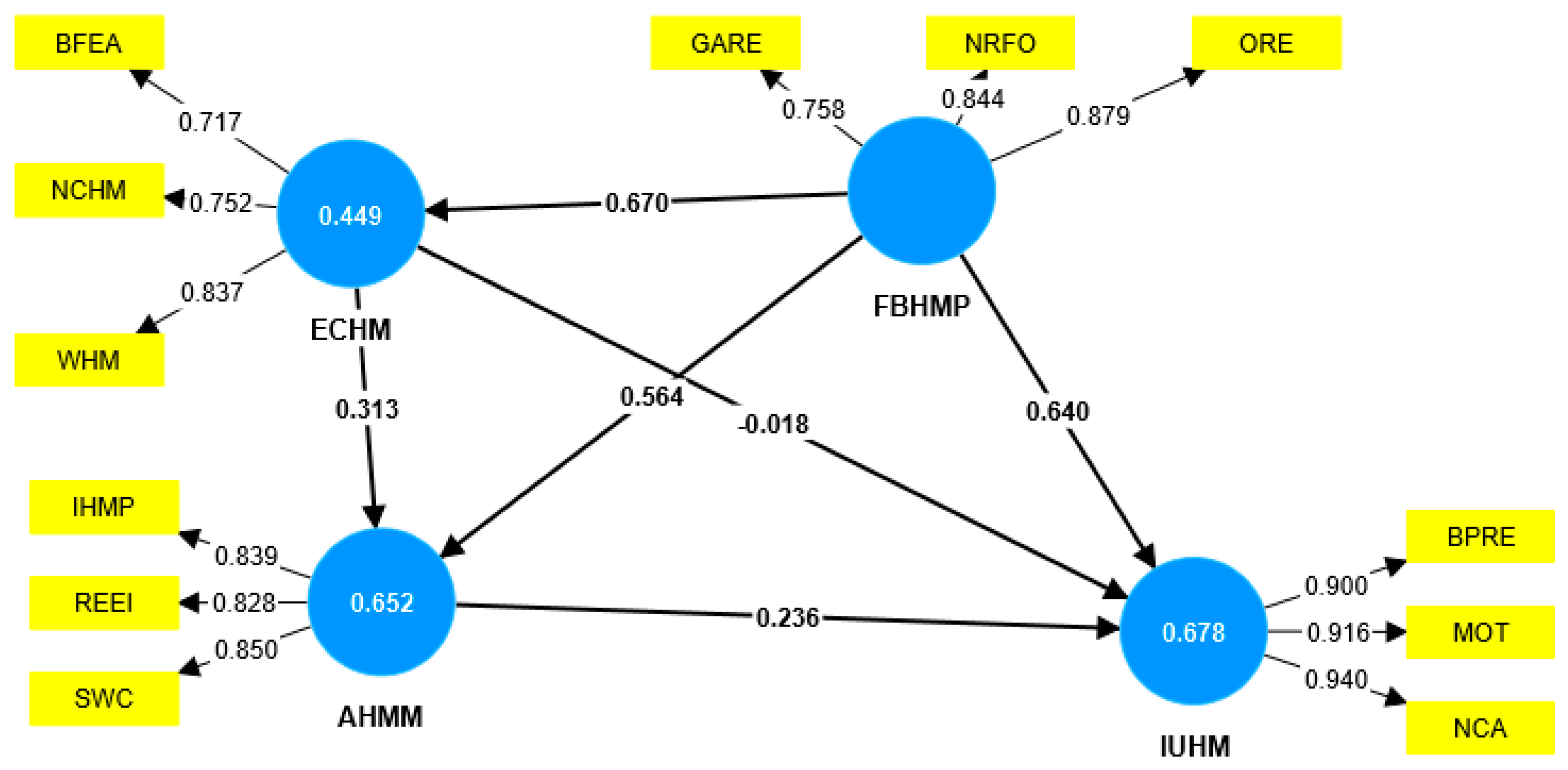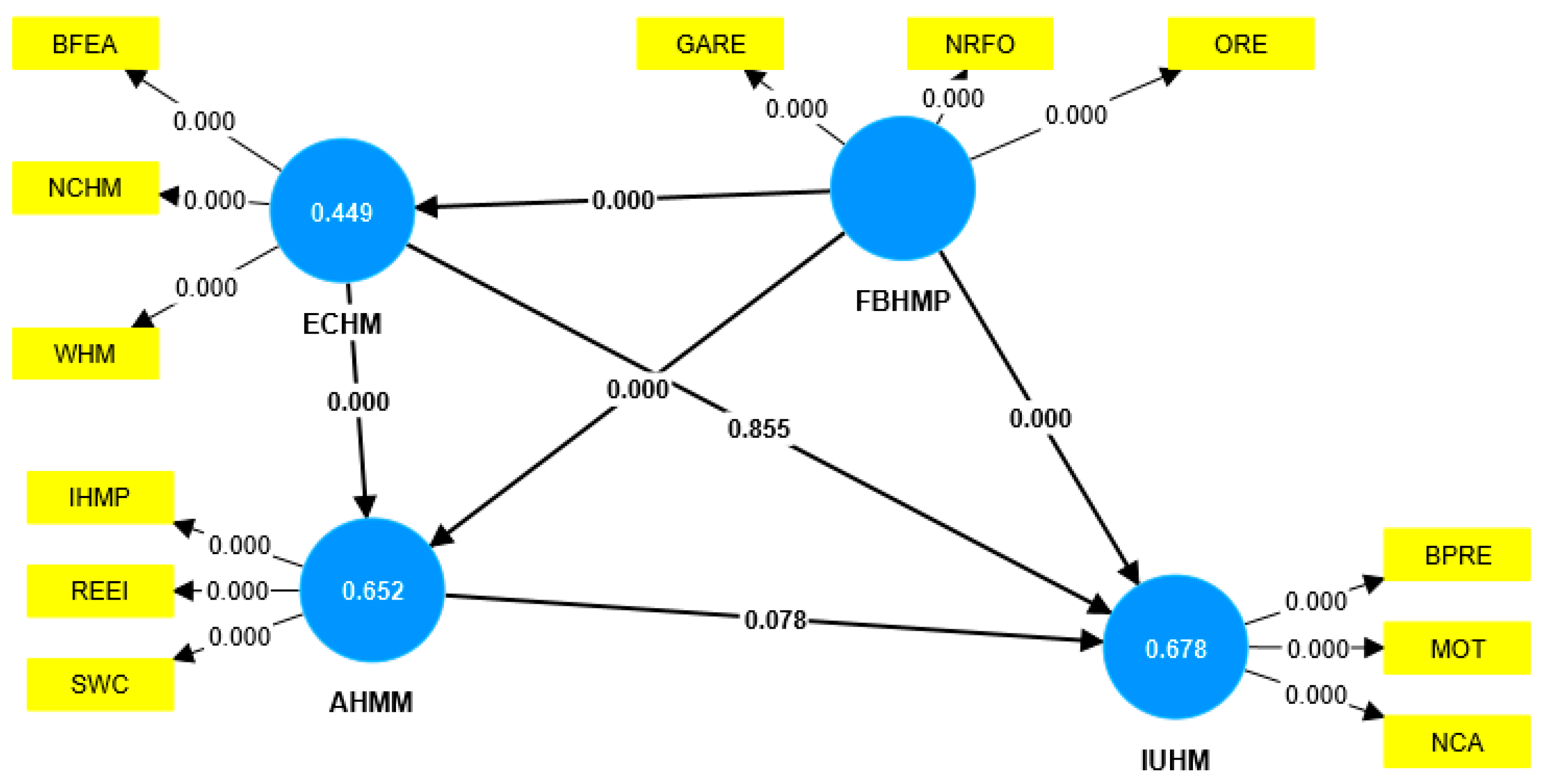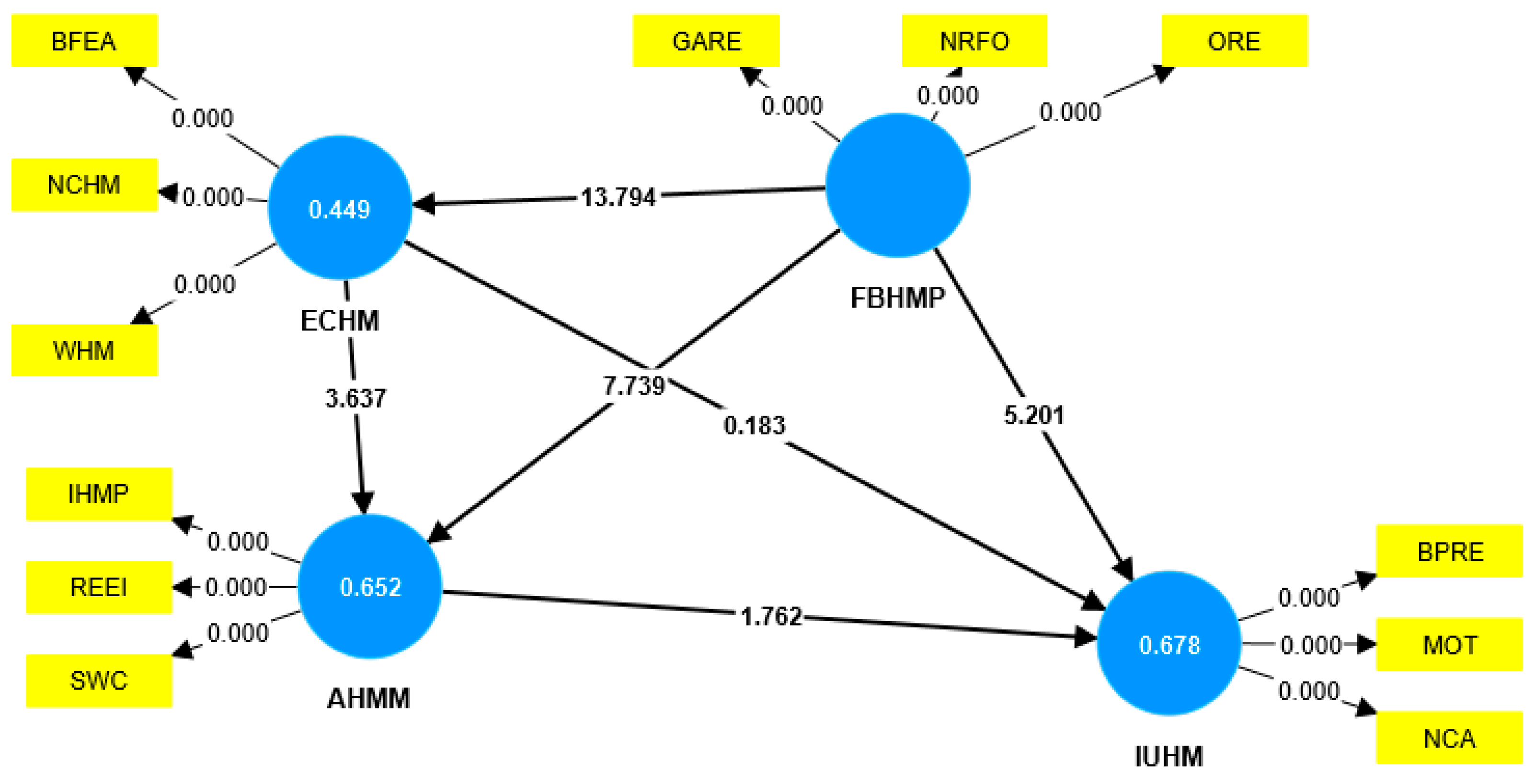1. Introduction
Energy plays an important role in the development of an economy, and its shortage is one of the main problems in developing countries. There is an urgent need to switch to renewable energy sources to save the ecological system and reduce pollution. To meet the demand and need for energy, special attention is paid to alternative sources of renewable energy, such as wind energy, solar energy or energy produced from biomass. Renewable energy, unlike thermal energy, also contributes to sustainable development, as it does not result in any direct emission of greenhouse gases [
1].
Global greenhouse gas emissions could be reduced by up to 63% by 2050 by adopting low-carbon and resource-efficient strategies [
2].
Renewable energies are essential parts of the energy revolution, in which the goal is to replace the production of fossil fuels with those from renewable sources. Photovoltaic energy and wind energy are such green energies, but they can be quite challenging for entrepreneurs because they are dependent on weather conditions [
3]. Biomasses are the sources that can present the greatest impact [
4], thus the use of renewable energy produced from manure helps to develop energy independence and fits into the concept of a circular economy, where waste and resources are capitalized and reused in a sustainable way, contributing to reducing the consumption of natural resources [
5].
Utilizing horse manure for renewable energy can contribute to the diversification of energy sources in Romania. Reducing dependence on fossil fuels and promoting renewable energy can enhance energy security.
Historically, as it can be seen in
Figure 1, Romania has had a significant reliance on coal and natural gas for electricity generation. However, there has been a gradual shift away from coal in favor of cleaner and more sustainable sources.
Romania has a significant hydropower capacity, primarily from its numerous rivers and mountainous regions, wind power and solar photovoltaic (PV) installations. Romania has been making efforts to transition toward a more sustainable and decarbonized energy system, which includes reducing its reliance on fossil fuels and increasing its share of renewables.
In recent years, Romania has shown an increased interest in renewable energy and the development of sustainable energy sources produced by the sun and wind, as can be seen in
Figure 2, and a very low interest in other sources, such as the processing of horse manure, presented in
Figure 3.
The transformation of manure into bioenergy can be met with skepticism by entrepreneurs due to fears related to investment, technological risk, logistics and the supply of raw materials. However, the transformation of manure into bioenergy can bring significant advantages, including the diversification of economic activity, a reduction in greenhouse gas emissions and the promotion of sustainable development, and an important fact is that the behavior of an entrepreneur can influence society’s attitude towards the environment.
On the other hand, it is important for Romanian entrepreneurs to diversify their portfolio regarding green energy and to give greater importance to the environment. Civil society is becoming more and more aware of the negative impact that pollution has, and they tend to appreciate and collaborate more with entrepreneurs educated in the spirit of eco-friendly decisions [
6]. Also, Cutcu et al. [
7] argued that quality of life is affected by the harmful effects of industrialization, even if it leads to economic growth and commercial openness. Consumers have become aware of these aspects and focus on purchasing products or services from entrepreneurs who adopt cleaner methods and who do not harm the environment.
Based on this research gap, we proposed the following research questions:
- RQ1:
Are entrepreneurs’ intentions for exploring renewable energy business opportunities motivated by concerns for sustainability and requirements to protect the environment?
- RQ2:
Are entrepreneurs aware of the sustainability of a business and the needs of society in the long term, or do they focus on short-term financial returns?
- RQ3:
What behavior is adopted or should be adopted by entrepreneurs in order to diversify their renewable energy portfolio by processing horse manure?
To answer these research questions, the present study proposes a model based on the Theory of Planned Behavior [
8]. According to the cognitive Theory of Planned Behavior (TPB), an individual’s decision to engage in a certain action can be influenced by their level of motivation to carry it out. The greater an entrepreneur’s purpose in undertaking sustainable behavior, the greater the chance of developing it. The adoption of renewable energy through manure processing can be influenced by perceived behavioral control, environmental attitude, cost value and social influence.
This research is based on the use of PLS-SEM structural equations, where it is examined by extracting the linear correlations of the observed variables under which conditions entrepreneurs want to change their sustainable behavior and where the desire for change in the production of renewable energy should be encouraged more. Therefore, the aim of this study is to provide a comprehensive analysis of entrepreneurs’ attitude towards sustainable behavior.
Green energy from organic waste, like horse manure, is a sustainable and environmentally friendly alternative to fossil fuels. In regions where horse breeding or agriculture is a significant industry, investing in horse-manure-based green energy can support rural development by creating jobs and providing additional income streams for local communities.
This study brings an element of novelty by understanding entrepreneurs’ attitude in this area, because it can accelerate this transition to reducing carbon footprints and contributing to a healthier planet. Entrepreneurial interest often drives innovation. Studying entrepreneurs’ interest in horse-manure-based green energy can lead to the development of improved technologies.
By delving into the motivations, awareness and behavioral patterns of entrepreneurs in the renewable energy sector, we hope to contribute valuable insights that can guide policy decisions and societal perspectives on environmental responsibility.
The structure of our study is outlined as follows: We begin with an exploration of the literature and theoretical foundations, followed by a detailed methodology section elucidating our employment of SEM-PLS and TPB. We then present our empirical findings and discuss their implications for both the entrepreneurial community and the broader field of sustainable energy. By investigating the behavior of entrepreneurs who are transforming horse manure into bioenergy, this study not only contributes valuable insights but also advances the cause of eco-friendly, renewable energy solutions.
2. Literature Review
2.1. Circular Economy
Over time, humans have exerted continuous pressure on the natural environment through the excessive use of resources and the generation of waste. The circular economy has emerged as a potential solution for solving these problems.
Kirchherr et al. [
9] tried to find a widely accepted definition of the circular economy but found that it has been defined in almost as many ways as there are researchers and practitioners, but the one common denominator in all definitions is the effort to better use resources. The circular economy involves building a balance between the use of existing resources and energy needs [
10].
The depletion of natural resources continues to accelerate, while mountains of waste still accumulate [
11]. Therefore, there is an urgent need to minimize resource exploitation and maximize the reintroduction of waste into the economy.
The environment can be negatively affected from an ecological point of view also by animal waste, but seen from another perspective, manure can be a valuable resource if it is introduced into the circular economy due to nitrogen and phosphorus, which can be important sources for the production of energy [
12]. Yildizbasi [
13] considered that an important section of the circular economy is the field of energy, because energy is needed to make some products or perform some services.
The circular economy has been implemented for hundreds of years, where byproducts from one industry form inputs for another [
14]; so, the circular economy undoubtedly has significant potential for sustainability. Suárez-Eiroa et al. [
15] argue that the circular economy operates under the banner of a sustainable development framework.
The circular economy plays an important role in reducing environmental pollution, as it includes a large potential for decarbonization [
16]. However, it must be taken into account that the reduction in emissions from one economic activity may lead to their increase in another. Murray et al. [
17] explained how palm oil transformed into biofuel can reduce dependence on fossil fuels but contribute to the accelerated deforestation of palm trees.
The circular economy can contribute to the sustainability of an enterprise or a country, but to prevent inappropriate measures, the weak relationship between the circular economy and sustainable development should be strengthened and rethought [
18].
Some principles of the circular economy emerged long ago from resource management, before the sustainable development debate, because waste management has always been an integral part of a community [
19].
Kirchherr et al. [
9] argue that the circular economy aims to contribute to sustainable development, but various factors have been found to either accelerate or hinder the development of sustainable businesses [
5].
The purpose of any business model is to create value, and a business model can only be profitable in the long term if it is able to create value for all actors involved. Business models based on the circular economy can increase long-term financial returns and reduce costs [
20].
Circular economy business models are considered to offer the opportunity to enhance social and environmental well-being in an economically viable way [
21] and create a better image for the firm [
22].
2.2. Renewable Energy Based on Horse Manure Processing
Both the reduction in waste and the development of new ways of reusing it are central objectives in the transition to a circular economy [
23]. Business models that capitalize on waste traded on the global market have become quite common in many industries and the target of considerable academic interest [
18].
Instead of finding optimal solutions for processing waste, some entrepreneurs have to pay considerable amounts of money to dispose of it. Manure serves as an example of a waste that has negative value to the farmer, because it is continuously generated and difficult to process cost-effectively [
24]. It is rich in nitrogen, which means that it is harmful to the environment, especially to rivers and lakes, and to a certain extent, it can be considered dangerous because it can spread diseases [
25].
A very important source of energy, but still unexploited to its true potential, is the manure produced by horses. It has been shown that the composition of this type of waste is the most feasible to produce energy, but the implementation costs represent a barrier for entrepreneurs [
26].
As pseudoruminants, horse manure is the most ideal compost material due to its high ammonium nitrogen ratio [
27]. Since ancient times, this product has been used to fertilize soils and crops and can be an asset if it is managed properly. However, before manure can be legally used as fertilizer, it must be burned or stored for up to nine months [
28], and this creates a storage problem and increases costs for an entrepreneur. The correct use of manure promotes sustainable agriculture and increases the production of agricultural crops, while contributing to the recovery and reuse of resources, according to the concept of circular economy.
Due to strict regulations on fertilizers, only a limited amount of manure can be used as fertilizer in agriculture, which makes the disposal of manure quite expensive [
29,
30,
31]. A manure management system that provides the opportunity to utilize it in an ecologically sustainable way would be ideal [
32].
Horse manure is generated in the millions of tones in horse-rich countries such as the UK, Germany and France. Horses produce from 18 to 25 kg of manure per day depending on feed, bedding and cleaning systems [
33] and can be an important source of income for some entrepreneurs, as it can be used in the production of biogas by extracting lignocellulosic fibers [
32]. During anaerobic digestion, lignocellulosic biomass is converted into biogas [
34], and biogas produced from manure processing mainly contains methane, which is a much stronger greenhouse gas than carbon dioxide.
By capturing and using biogas, methane emissions into the atmosphere are reduced, thus contributing to the fight against climate change, and in addition, it generates renewable energy that can be used to power electrical systems, as well as to produce heat and thermal energy. This contributes to diversifying the energy source and reducing dependence on fossil fuels [
35].
The livestock sector is currently facing pressure on sustainability, and the contribution of animals to protecting the environment is often underestimated, as many entrepreneurs or horse owners do not apply recommended manure management practices and a large amount of nutrients can be lost to the environment, which leads to air, water and soil contamination [
36].
Entrepreneurs can collaborate with farms and equine centers to gain access to significant amounts of manure. These collaborations can be mutually beneficial, as the entrepreneur obtains the raw material needed for renewable energy production and farmers can reduce waste management costs.
2.3. The Theory of Planned Behavior in Sustainable Entrepreneurship
The Theory of Planned Behavior (TPB) can be applied in entrepreneurship to understand and improve the behaviors and decisions of entrepreneurs. The TPB was developed by Ajzen [
8] in the field of social psychology and is used to predict and explain human behavior in various contexts, including sustainable entrepreneurship.
To study the behavior and motivations of an energy entrepreneur, it was considered appropriate to apply the TPB because it is a well-established theory to predict behavior through intention. Although intention may not always lead to behavior, many studies show that intention is a valid predictor of behavior for various subjects [
37].
Behavioral intention is a person’s motivation in terms of their conscious plan, decision or self-instruction to exert effort to achieve the target behavior [
38].
TPB is also concerned with environmental behavior research, which examines sustainable and conscious behavior in terms of consumption, energy, food and mobility [
39]. The application of the TPB helps to analyze the concern for the environment of the electricity entrepreneurs, the attitude towards the development of the renewable energy portfolio and the subjective norms and financial skills for the intention to use renewable energy through the processing of manure [
40].
Climate change has a significant impact on the whole world, and to recover from the crisis situation we are in, altering societal behavior and focusing on technical innovations can help solve the problems [
41]. Gansser and Reich [
39] argue the same and explain how changes in human behavior and technical innovations can remedy the problems of environmental pollution and avoid a climate catastrophe. Entrepreneurs can assess their level of control over the business environment and develop strategies to cope with the uncertainties and risks of the global economy.
At first, it was thought that investing in the development of technology could fix the problems facing humanity, but over time, some studies have shown that changing society’s behavior towards a sustainable one and adopting an environmentally friendly lifestyle are more important than the development of new technologies [
41].
As Conner and Sparks [
42] argue, behaviors must be understood not only in terms of beliefs, values, perceived norms and perceived control but also in terms of the individual’s behavioral history and the broader social influences that may be operative.
Therefore, the application of the Theory of Planned Behavior in sustainable entrepreneurship can contribute to the understanding and optimization of the behaviors and decisions of entrepreneurs, thus supporting the development of their business and increasing the chances of success.
3. Materials and Methods
3.1. Sample and Data Collection
To test the hypotheses of this study, a questionnaire (
Appendix A) was sent online to entrepreneurs who own photovoltaic parks, wind parks or have the intention of developing a business in the energy sector. This research focused on the evaluation of the interest shown for expanding a business based on renewable energy by processing horse manure into bioenergy. Willaby et al. [
43] argued that a sample size of 100 is sufficient for the application of the Partial Least Squares method, which is used in this research. Therefore, the 104 answers collected and validated can be considered sufficient for this study. The characteristics of the respondents from different areas of Romania and from different areas of activation can be found in
Table 1.
It can be seen that most respondents are female, with ages between 20–35 years, and with fewer than 5 years of entrepreneurial experience.
The main hypothesis and data from which this study started, according to
Table 2, were based on the assessment of an entrepreneur’s interest by applying the Theory of Planned Behavior, the main components being the following:
Perceived behavioral control: The degree to which the entrepreneur believes that the actions and results related to their business influence the level of environmental pollution and how they can stop this aspect.
Attitude: The entrepreneur’s perspective toward a particular action or decision in relation to the business. It is about the subjective assessment of the potential benefits and consequences of an action, such as the storage and processing of horse manure.
Subjective norms: The entrepreneur’s perceptions regarding achieving the highest possible profit regardless of the consequences. These rules can ensure a certain status in the family, among friends, investors or other people from their business environment.
Following these aspects, entrepreneurs in the field of renewable energy can evaluate their attitude towards different aspects of the business, such as innovation, risk taking or developing a business plan by expanding the object of activity through manure processing.
In order to identify the intentions of entrepreneurs in the field of renewable energy, we conducted research starting from the hypotheses presented in
Table 3.
As a research method, we selected Structural Equation Modeling, using the Partial Least Squares method. Partial Least Squares Structural Equation Modeling (PLS-SEM) is an advanced analysis technique used to assess complex relationships between latent variables in scientific research and data analysis [
54]. The purpose of this modeling is to identify important covariance-based modeling constructs.
3.2. Conceptual Model
The conceptual model presented in
Figure 4 reflects the links between the latent variables, as well as the formative and reflective measurement models of the variables.
Structural models allow the representation of hypotheses and relationships between latent variables, which are examined when PLS-SEM is applied [
55]. The structural model presented in
Figure 1 presents four latent variables (ECHM, AHMM, IUHM and FBHMP), and the indicators contain the research results, evaluated through a 5-point Likert scale (from 1—Total disagreement to 5—Total agreement).
4. Results
The structural model in
Figure 5 shows us that the financial benefits (FBHMP) that can be obtained from the transformation of manure into renewable energy can arouse entrepreneurs’ concern for environmental protection (ECHM) (correlation coefficient 0.670), but entrepreneurs’ concern for environmental pollution does not represent a sufficiently important factor to develop their business portfolio through garbage processing (negative correlation coefficient 0.018).
However, there is interest in developing a sustainable business model through horse manure resulting in renewable energy only if the financial benefits that can be obtained are as expected (relationship coefficient 0.640).
The relationship coefficients are calculated by SmartPLS 4 software and illustrated in
Figure 3. The variables
Environmental concerns related to horse manure (ECHM),
Attitude to horse manure management (AHMM) and
Financial benefits of horse manure processing (FBHMP) explain 67.8% of the variance in the variable
Intention to use horse manure as renewable energy (IUHM) (coefficient of determination R2 = 0.678).
The variables FBHMP and ECHM explain 65.2% of the variance of the endogenous variable AHMM (coefficient of determination R2 = 0.652), and the variable FBHMP explains 44.9% of the variance of the endogenous variable ECHM (coefficient of determination R2 = 0.449).
An evaluation of the reflective measurement model was also conducted by determining the level of consistency, level of confidence and convergent validity.
Cronbach’s Alpha tests the validity of internal consistency by reflecting how correlated the variables are within the structural model, as can be seen in
Table 4. The minimum threshold accepted for this indicator is 0.7, validating only the reflective variables AHMM, FBHMP and IUHM, ECHM being below the threshold at the value of 0.659.
The Composite Reliability (CR) is an indicator of reliability, and acceptable values are generally considered above the threshold of 0.7. For this model, the situation is similar to Cronbach’s Alpha, the ECHM variable being below the minimum accepted threshold.
Spearman’s rank correlation coefficient (Rho) is a non-parametric test used to measure the magnitude of association between two variables, where the value r = 1 means a perfect positive correlation and the value r = −1 means a perfect negative correlation. In
Table 4, it can be seen that all reflective variables have a positive correlation.
Average variance extracted (AVE) assesses the convergent validity of the model and measures the variance that is captured by a variable relative to the variance due to measurement error. It can be seen that all variables have an AVE above the recommended threshold of 0.5.
The Fornell–Larcker criterion compares the square root of the average variance extracted (AVE) with the correlation of the latent variables. It is recommended that the square root of the AVE of each reflective variable has a higher value than the correlations with other latent variables, a fact confirmed in this empirical research (as the AVE values for AHMM (0.839), ECHM (0.770), FBHMP (0.829) and IUHM (0.919) are higher than the correlations with the other latent variables, illustrated below the main diagonal in
Table 5).
The Heterotrait Monotrait Correlation Ratio (HTMT) manages to achieve a higher degree of reliability compared with the cross-loading criterion and the Fornell–Lacker criterion. HTMT values close to 1 indicate a lack of discriminant validity. If the HTMT value is greater than this threshold, it can be concluded that there is a lack of discriminant validity. Most statisticians recommend a minimum threshold of 0.85.
In case of this research, the HTMT is below the threshold of 0.85 only in the case of the structural relationships between the variables AHMM and IUHM, respectively, ECHM and IUHM—
Table 6.
PLS-SEM relies on a non-parametric bootstrap procedure to test the significance of relationship coefficients estimated in PLS-SEM. The parameter estimates are used to obtain standard errors for the estimates. With this information, T-test values and asymptotic significances (p-values) are calculated to assess the significance of each estimate and validate or reject the research hypotheses.
Figure 6 reflects the structural model generated after applying the bootstrap procedure, in which the asymptotic significance values (
p-value) are highlighted on the link relationships between the latent variables.
Only four hypotheses out of six are validated (
Table 7), the
p-value exceeds the maximum significance level allowed of 0.05 for the hypothesis ECHM-IUHM (0.855 > 0.05) and AHMM-IUHM (0.078 > 0.05)
The
t-test shows the magnitude of the correlation between the latent variables in this structural model. Thus, according to
Figure 7, the financial benefits (FBHMP) can have the strongest impact on entrepreneurs to develop their business, taking into account the protection of the environment by processing manure into bioenergy (ECHM) (T-test = 13.794,
p-value tends to zero).
Concern for the environment (ECHM) has the lowest impact on the decision to develop a sustainable business model based on the production of renewable energy through horse manure (IUHM), (t-test = 0.183, p value = 0.855).
5. Discussion
Attitude, perceived behavioral control and subjective norms are significant predictors of entrepreneurial intention used in the TPB, and the present study presents the intention of entrepreneurs regarding the development of a business in the field of energy by processing horse manure. The use of renewable energies helps to reduce greenhouse gas emissions and, implicitly, to reduce climate change. Diversifying the renewable energy portfolio by processing horse manure can be an innovative idea for entrepreneurs. This approach involves turning organic waste, such as manure, into biogas and other renewable energy sources. To face the environmental challenges, the development of the renewable energy portfolio would be an optimal solution, as it would represent a basic pillar of energy security and sustainable development in both developed and developing countries [
56].
Tang [
57] argued that the attitude and traits of an entrepreneur mostly influence the evolution of a society. Given the technological evolution and increasing demand for clean energy, entrepreneurs can find a favorable environment here for business development. Therefore, entrepreneurs who engage in such businesses make a significant contribution in the fight against global warming and environmental pollution.
Communities and consumers show more and more concern for protecting the environment and adopting sustainable solutions, improving quality of life and creating new jobs as social benefits [
58]. Thus, entrepreneurs who develop businesses in the field of renewable energies can benefit from a positive image and can more easily attract loyal customers.
Lortie and Castogovianni [
59] argued that the link between intentions and the ability of entrepreneurs to identify opportunities should be further examined. However, according to the present study, the surveyed entrepreneurs did not show such a great interest in sustainability and the environment in the development of renewable energy portfolios through the processing of horse manure (RQ1). Zuk and Zuk [
60] noted that one of the reasons why entrepreneurs are afraid to apply or develop their business for a sustainable purpose is related to the cost of the energy transition and the implementation of the sustainable project. Allocating funds for research and development in horse manure conversion technologies, especially to improve efficiency and reduce costs, can encourage entrepreneurs to diversify their energy portfolio.
Another solution for accelerating the transition towards diversifying the portfolio with renewable energies can be represented by intersectoral partnerships [
61]. However, the attitude of entrepreneurs towards ecological factors may differ depending on the company’s objective and its need to be placed on the market.
It is important to emphasize that entrepreneurs may have different perspectives on the sustainability of a business, and their priorities may vary depending on the economic, social and legislative context in which they operate. Entrepreneurs must carry out detailed market research on the potential of processing manure into renewable energy. This includes analyzing the technologies available to produce biogas and other forms of energy, assessing the demand for renewable energy in the region and identifying possible partnerships or government support.
For some entrepreneurs, the main objective may be to achieve maximum financial return in the short term, without necessarily focusing on sustainability or long-term social and environmental impact. On the other hand, Mustafa et al. [
1] stated that if entrepreneurs and others are aware of the benefits that their business can have on the environment, they would be much more determined to invest in biomass-based renewable energy. Yi [
62] claims that a rather important role in environmental protection is green entrepreneurship, and an important factor for achieving this requirement is the implementation of ecological entrepreneurial education in school.
There is an acute need to protect communities and the environment and at the same time increase energy independence [
63]. Governments and international organizations support the development of renewable energies through policies, subsidy programs and tax incentives. These measures encourage entrepreneurs to invest in such projects, reducing financial risks and facilitating the growth of the sector. Therefore, these financial benefits may be the main reason why an entrepreneur decides to develop a renewable energy business and is less aware of business sustainability factors or long-term societal needs (RQ2).
Sung and Park [
64] describe the relationship between sustainability and entrepreneurship as a trade-off relationship—the greater the social and environmental consideration, the lower the economic benefits—but entrepreneurs should strive to achieve a balance between the two key concepts in economics.
Diversifying renewable energy portfolios through manure processing can be a promising initiative for entrepreneurs, with significant ecological and economic benefits. With appropriate research, infrastructure investment and strategic collaborations, this approach can help create a sustainable renewable energy business model (RQ3).
6. Conclusions
The results of this study highlight the influence of factors driving entrepreneurial intentions among energy entrepreneurs. The TPB basic model was tested in the context of sustainable entrepreneurship by processing the manure produced by horses, finding that attitudes towards sustainability, subjective norms and perceived behavioral control determine entrepreneurial intentions from the perspective of economic–financial interests but less from sustainable ones. Kuckertz and Wagner [
65] studied individuals’ concern with sustainability issues and found that the exploitation of sustainable-development-oriented entrepreneurial opportunities disappears as business experience is gained.
Developing a business through manure processing is an initiative with multiple benefits, and this research can contribute to changing the attitude and level of awareness of entrepreneurs regarding increasing the sustainability and profitability of a business. It is important to encourage partnerships between research institutions, businesses and government agencies to accelerate innovation and knowledge sharing.
This study was carried out on a sample of entrepreneurs from Romania, but it would be interesting to expand it internationally in order to have a comparative analysis of the results.
This research provides valuable information, as it supports the utility of the TPB in the field of green energy and explains under what conditions entrepreneurs’ attitudes, social norms and control beliefs toward green energy will affect their behavioral intentions. However, measuring these constructs can be difficult, because they are subjective and can vary across context and time.
Studying entrepreneurs’ interest in this field can foster international collaboration and knowledge sharing, as green energy solutions from organic waste can be applied in various regions facing similar environmental and waste management challenges.
